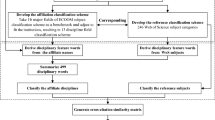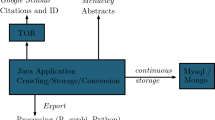Abstract
In this study we explore the disciplinary diversity present within subject specialties in the social sciences and humanities. Subject specialties are operationalized as textually coherent clusters of documents. We apply topic modelling to textual information on the individual document level (titles and abstracts) to cluster a multilingual set of roughly 45,000 documents into subject specialties. The dataset includes the metadata of journal articles, conference proceedings, book chapters, and monographs. We make use of two indicators, namely, the organizational affiliation based on the departmental address of the authors and the cognitive orientation based on the disciplinary classifications at the publication level. First, we study the disciplinary diversity of the clusters by calculating a Hill-type diversity index. We draw an overall picture of the distribution of subject specialties over diversity scores and contrast the two indicators with each other. The goal is to discover whether some subject specialties are inherently multi- or interdisciplinary in nature, and whether the different indicators are telling a well-aligned, similar story. Second, for each cluster of documents we calculate the dominance, i.e. the relative size of the largest discipline. This proxy of disciplinary concentration gives an idea of the extent to which a specialty is disciplined. The results show that all subject specialties analyzed serve as interdisciplinary trading grounds, with outliers in both directions of the disciplinary-interdisciplinary continuum. For a large share of specialties, the dominant cognitive and organizational disciplinary classification were found to be well aligned. We present a typology of subject specialties by contrasting the organizational and cognitive diversity scores.









Similar content being viewed by others
Availability of data and code
Notebook and data to be published on Github: https://github.com/JoshuaE1/interdisciplinarity-subject-specialties-SSH.
References
Abbott, A. D. (2010). Chaos of Disciplines. University of Chicago Press.
Angelov, D. (2020). Top2Vec: Distributed Representations of Topics. Arxiv preprint arXiv:2008:09470.
Campbell, D. T. (1969). Ethnocentrism of disciplines and the fish-scale model of omniscience. In M. Sherif & C. W. Sherif (Eds.), Interdisciplinary Relationships in the Social Sciences (pp. 328–348). Aldine.
Campello, R. J. G. B., Moulavi, D., & Sander, J. (2013). Density-based clustering based on hierarchical density estimates. In J. Pei, V. S. Tseng, L. Cao, H. Motoda, & G. Xu (Eds.), Advances in Knowledge Discovery and Data Mining. PAKDD 2013. Lecture Notes in Computer Science (Vol. 7819, pp. 160–172). Springer.
Cer, D., Yang, Y., Kong, S.-Y., Hua, N., Limtiaco, N., John, R. S., et al. (2018). Universal Sentence Encoder. arXiv preprint : ArXiv:1803.11175v2.
Durkheim, E. (2014). The Division of Labor in Society. Free Press.
Engels, T. C. E., & Guns, R. (2018). The Flemish performance-based research funding system: A unique variant of the Nowegian model. Journal of Data and Information Science, 3(4), 45–60. https://doi.org/10.2478/jdis-2018-0020
Ester, M., Kriegel, H.-P., Sander, J., & Xu, X. (1996). A density-based algorithm for discovering clusters in large spatial databases with noise. In E. Simoudis, J. Han, & U. Fayyad (Eds.), Proceedings of the second international conference on knowledge discovery and data mining, August 2–4, Portland, Oregon, USA (pp. 226–231): Association for the Advancement of Artificial Intelligence.
Eykens, J., Guns, R., & Engels, T. C. E. (2021). Clustering social sciences and humanities publications: Can word and document embeddings improve cluster quality? In W. Glänzel, S. Heeffer, P.-S. Chi, & R. Rousseau (Eds.), Proceedings of the 18th conference of the International Society for Scientometrics and Informetrics (pp. 369–374). Leuven, Belgium: International Society for Scientometrics and Informetrics.
Graff, H. J. (2015). Undisciplining Knowledge: Interdisciplinarity in the Twentieth Century. Johns Hopkins University Press.
Guns, R., Sīle, L., Eykens, J., Verleysen, F. T., & Engels, T. C. E. (2018). A comparison of cognitive and organizational classification of publications in the social sciences and humanities. Scientometrics, 116(2), 1093–1111. https://doi.org/10.1007/s11192-018-2775-x
Hammarfelt, B. (2018). What is a discipline? The conceptualization of research areas and their operationalization in bibliometric research. In R. Costas, T. Franssen, & A. Yegros-Yegros (Eds.), Science, Technology and Innovation Indicators in Transition—STI2018 (pp. 197–203). Centre for Science and Technology Studies (CWTS), Leiden University, The Netherlands.
Huutoniemi, K., Klein, J. T., Bruun, H., & Hukkinen, J. (2010). Analyzing Interdisciplinarity: Typology and Indicators. Research Policy, 39(1), 79–88. https://doi.org/10.1016/j.respol.2009.09.011
Jacobs, J. (2013). In Defense of Disciplines: Interdisciplinarity and Specialization in the Research University. University of Chicago Press.
Jost, L. (2009). Mismeasuring biological diversity: Response to Hoffmann and Hoffmann (2008). Ecological Economics, 68(4), 925–928. https://doi.org/10.1016/j.ecolecon.2008.10.015
Karunan, K., Lathabai, H. H., & Prabhakaran, T. (2017). Discovering interdisciplinary interactions between two research fields using citation networks. Scientometrics, 113(1), 335–367. https://doi.org/10.1007/s11192-017-2481-0
Le, Q., & Mikolov, T. (2014). Distributed Representations of Sentences and Documents. In Proceedings of the 31st international conference on machine learning (Vol. 32). Beijing, China: JMLR: W&CP.
Leydesdorff, L., & Probst, C. (2009). The delineation of an interdisciplinary specialty in terms of a journal set: The case of communication studies. Journal of the American Society for Information Science and Technology, 60(8), 1710–1718. https://doi.org/10.1002/asi.21052
Leydesdorff, L., Wagner, C. S., & Bornmann, L. (2018). Betweenness and diversity in journal citation networks as measures of interdisciplinarity A Tribute to Eugene Garfield. Scientometrics, 114(2), 567–592. https://doi.org/10.1007/s11192-017-2528-2
Leydesdorff, L., Wagner, C. S., & Bornmann, L. (2019). Interdisciplinarity as diversity in citation patterns among journals: Rao-Stirling diversity, relative variety, and the Gini coefficient. Journal of Informetrics, 13(1), 255–269. https://doi.org/10.1016/j.joi.2018.12.006
McCain, K. W. (1998). Neural networks research in context: A longitudinal journal cocitation analysis of an emerging interdisciplinary field. Scientometrics, 41, 389–410. https://doi.org/10.1007/BF02459053
McInnes, L., Healy, J., & Melville, J. (2018). UMAP: Uniform Manifold Approximation and Projection for Dimension Reduction. arXiv preprint: arXiv:1802.03426.
Mikolov, T., Chen, K., Corrado, G., & Dean, J. (2013). Efficient Estimation of Word Representations in Vector Space. arXiv preprint.: arXiv:1301.3781.
Noichl, M. (2019). Modeling the structure of recent philosophy. Synthese, 198, 5089–5100. https://doi.org/10.1007/s11229-019-02390-8
Núñez, R., Allen, M., Gao, R., Rigoli, C. M., Relaford-Doyle, J., & Semenuks, A. (2019). What happened to cognitive science? Nature Human Behaviour, 3(8), 782–791. https://doi.org/10.1038/s41562-019-0626-2
Ostrom, E. (2007). Challenges and growth: The development of the interdisciplinary field of institutional analysis. Journal of Institutional Economics, 3(3), 239–264. https://doi.org/10.1017/S1744137407000719
Porter, A. L., & Rafols, I. (2009). Is science becoming more interdisciplinary? Measuring and mapping six research fields over time. Scientometrics, 81(3), 719–745. https://doi.org/10.1007/s11192-008-2197-2
Schoepflin, U., & Glänzel, W. (2001). Two decades of “Scientometrics”: An interdisciplinary field represented by its leading journal. Scientometrics, 50(2), 301–312. https://doi.org/10.1023/A:1010577824449
Sīle, L., Guns, R., Vandermoere, F., Sivertsen, G., & Engels, T. C. E. (2021). Tracing the context in disciplinary classifications: A bibliometric pairwise comparison of five classifications of journals in the social sciences and humanities Quantitative. Science Studies, 2(1), 65–88. https://doi.org/10.1162/qss_a_00110
Small, H., & Crane, D. (1979). Specialties and disciplines in science and social science: An examination of their structure using citation indexes. Scientometrics, 1, 445–461. https://doi.org/10.1007/BF02016661
Sugimoto, C. R., & Weingart, S. (2015). The kaleidoscope of disciplinarity. Journal of Documentation, 77(4), 775–794. https://doi.org/10.1108/JD-06-2014-0082
Truc, A., Santerre, O., Gingras, Y., & Claveau, F. (2020). The Interdisciplinarity of Economics. SSRN Scholarly Paper ID 3669335, Rochester, NY: Social Science Research Network.
van Baalen, P., & Karsten, L. (2012). The evolution of management as an interdisciplinary field. Journal of Management History, 18(2), 219–237. https://doi.org/10.1108/17511341211206861
Van den Besselaar, P. (2019, 11th April 2019). Interdisciplinary and disciplinary identities: towards a theory of forms of knowledge change. pre-print. BioRxiv.
Van den Besselaar, P., & Leydesdorff, L. (1996). Mapping change in scientific specialties: A scientometric reconstruction of the development of articial intelligence. Journal of the American Society for Information Science, 47(6), 415–436. https://doi.org/10.1002/(SICI)1097-4571(199606)47:6%3c415::AID-ASI3%3e3.0.CO;2-Y
Vandermoere, F., & Vanderstraeten, R. (2012). Disciplinary networks and bounding: Scientific communication between science and technology studies and history of science. Minerva, 50(4), 451–470. https://doi.org/10.1007/s11024-012-9210-x
Vanderstraeten, R. (2021). Publikations- und Evaluationspraktiken in wissenschaftlichen Zeitschriften, 1930–2020. Zeitschrift Für Soziologie, 50(3–4), 274–287. https://doi.org/10.1515/zfsoz-2021-0019
Vanderstraeten, R., & Vandermoere, F. (2015). Disciplined by the discipline: A social-epistemic fingerprint of the history of science. Science in Context, 28(2), 195–214. https://doi.org/10.1017/S0269889715000058
Vanderstraeten, R., & Vandermoere, F. (2021). Inequalities in the growth of Web of Science. Scientometrics, 126(10), 8635–8651. https://doi.org/10.1007/s11192-021-04143-2
Verleysen, F. T., Ghesquière, P., & Engels, T. C. E. (2014). The objectives, design and selection process of the Flemish Academic Bibliographic Database for the Social Sciences and Humanities (VABB-SHW). In W. Blockmans, L. Engwall, & D. Weaire (Eds.), Bibliometrics. Use and Abuse in the Review of Research Performance (pp. 117–127). London: Portland Press.
Vugteveen, P., Lenders, R., & Van den Besselaar, P. (2014). The dynamics of interdisciplinary research fields: The case of river research. Scientometrics, 100, 73–96. https://doi.org/10.1007/s11192-014-1286-7
Wright, B. E. (2011). Public administration as an interdisciplinary field: Assessing its relationship with the fields of law, management, and political science. Public Administration Review, 71(1), 96–101. https://doi.org/10.1111/j.1540-6210.2010.02310.x
Yan, E., Ding, Y., Cronin, B., & Leydesdorff, L. (2013). A bird’s-eye view of scientific trading: Dependency relations among fields of science. Journal of Informetrics, 7(2), 249–264. https://doi.org/10.1016/j.joi.2012.11.008
Zhang, L., Rousseau, R., & Glänzel, W. (2015). Diversity of references as an indicator of the interdisciplinarity of journals: Taking similarity between subject fields into account. JASIST-Journal of the Association for Information Science and Technology, 67(5), 1257–1265. https://doi.org/10.1002/asi.23487
Acknowledgements
This paper is a substantially extended version of a research in progress paper presented at the ISSI2021 conference titled ‘Clustering social sciences and humanities publications: Can word and document embeddings improve cluster quality?’ (Eykens, Guns, & Engels, 2021). We would like to thank Hongyu Zhou for his suggestions made about the visualization which helped improve this paper.
Funding
This investigation has been made possible by the financial support of the Flemish government to ECOOM.
Author information
Authors and Affiliations
Contributions
JE, RG, RV: Conceptualization, JE, RG: Methodology, JE, RG: Software, JE: Validation, JE: Formal analysis, JE: Investigation, RG: Resources, JE, RG: Data curation, JE, RV: Writing—Original draft, JE, RG, RV: Writing—Review and editing, JE, RG: Visualization, JE, RG: Supervision, JE: Project administration, RG: Funding acquisition.
Corresponding author
Ethics declarations
Conflict of interest
Not applicable.
Rights and permissions
About this article
Cite this article
Eykens, J., Guns, R. & Vanderstraeten, R. Subject specialties as interdisciplinary trading grounds: the case of the social sciences and humanities. Scientometrics 127, 7193–7213 (2022). https://doi.org/10.1007/s11192-021-04254-w
Received:
Accepted:
Published:
Issue Date:
DOI: https://doi.org/10.1007/s11192-021-04254-w




